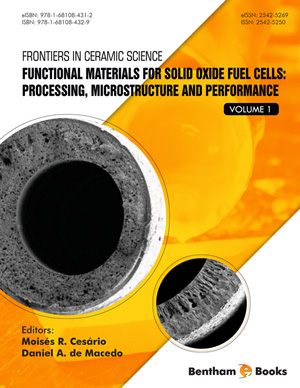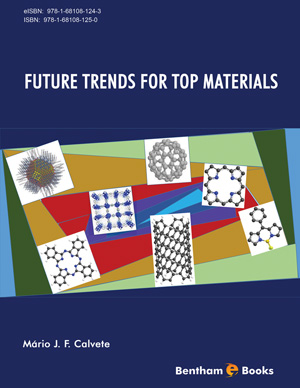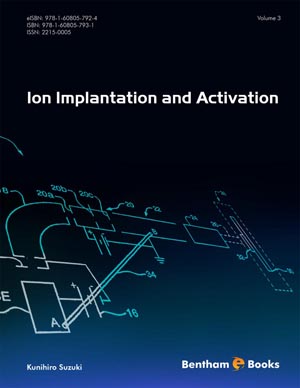About the Editors
Page: i-iii (3)
Author: Filipe Vaz, Nicolas Martin and Martin Fenker
DOI: 10.2174/9781608051564113010001
Preface
Page: v-vii (3)
Author: Filipe Vaz, Nicolas Martin and Martin Fenker
DOI: 10.2174/9781608051564113010003
List of Contributors
Page: viii-xi (4)
Author: Filipe Vaz, Nicolas Martin and Martin Fenker
DOI: 10.2174/9781608051564113010004
Modelling of Reactive Sputter Deposition of Oxynitrides
Page: 3-26 (24)
Author: Sören Berg, Tomas Nyberg and Diederik Depla
DOI: 10.2174/9781608051564113010005
PDF Price: $15
Abstract
Reactive sputter deposition is frequently carried out in a mixture of argon and oxygen or nitrogen to obtain oxides and nitrides. The behavior of such "single-reactive gas" processes has been explained theoretically and verified by numerous industrial thin film deposition applications. However, mixing two reactive gases with the argon sputtering gas in order to carry out reactive sputter deposition of oxy-nitride films is a far more complicated process. A first order simple process model for such a mixed process is presented. Modelling indicates that altering the supply of one gas will not only cause a change of the partial pressure of this gas but also may significantly change the partial pressure of the other reactive gas. Moreover, different reactivities of the reactive gases result in stoichiometries that are very different from the relative reactive gas supplies. This linked behavior between the reactive gases may cause severe process control problems. In a second part of the chapter, a more advanced model is presented, which includes reactive ion implantation and knock-on implantation. First this model is tested vs. experimental results published in literature. Based on the good agreement in the noticed trends, the time dependence of the poisoning behavior of the target is discussed. Finally, the influence of the deposition profile on the hysteresis behavior, and the composition of the oxynitride is discussed, showing the importance of a complete model.
Reactive Gas Pulsing Process for Oxynitride Thin Films
Page: 27-50 (24)
Author: Nicolas Martin, Jan Lintymer, Aurélien Besnard and Fabrice Sthal
DOI: 10.2174/9781608051564113010006
PDF Price: $15
Abstract
An original reactive sputtering method, namely the reactive gas pulsing process (RGPP) was developed for the synthesis of titanium oxynitride thin films. Such a method implements a metallic titanium target dc sputtered, a constant supply of argon and nitrogen gases and a pulsing oxygen mass flow rate, which is periodically controlled vs. time. Various period times and different patterns can be generated: rectangle, sine, isosceles triangle, mounting or descending triangle and exponential. Real-time measurements of the target potential as well as total sputtering pressure are recorded in order to study the instability phenomena of the process. They are also pertinent diagnostic tools to select the most suitable pulsing patterns required to alternate the process between the nitrided and the oxidized sputtering modes. As a result, alternation is produced for exponential and rectangular patterns. For the latter, the influence of the duty cycle α, defined as the ratio of the injection time of oxygen by the pulsing period, on the behaviour of the reactive sputtering process and optical properties of deposited films, is systematically investigated. Finally, the added value brought by the exponential patterns is examined. It is shown that the exponential pulse leads to significant improvements of the oxygen injection. The purpose is to introduce the right amount of oxygen so as to poison the titanium target surface without saturating the sputtering atmosphere by oxygen. Thus, the speed of pollution of the target surface appears as an appropriate parameter to better understand the beneficial effect of the exponential shape on the control of the RGPP method.
Exploring the Potential of High Power Impulse Magnetron Sputtering for Tailoring the Chemical Composition and the Properties in Metal Oxynitride Films
Page: 51-63 (13)
Author: Kostas Sarakinos
DOI: 10.2174/9781608051564113010007
PDF Price: $15
Abstract
Metal oxynitrides (MONs) are a new class of functional materials in which tuning of the O-to-N ratio in the non-metal sublattice enables to tailor their properties between those of the reference metal oxide and the metal nitride systems. In thin film form MONs are frequently deposited by reactive magnetron sputtering techniques under the presence of two reactive gases (O2 and N2). In this case the ability to control the Oto- N ratio in the growing MON films is largely determined by the stability of the reactive sputtering process in the transition zone between metallic and compound target. Recently it has been shown that the implementation of a newly developed highly ionized magnetron sputtering technique, i.e., the high power impulse magnetron sputtering (HiPIMS), can also allow for a stable operation during reactive deposition of metal oxides. In this chapter the state of the art regarding the process characteristics in reactive HiPIMS processes are reviewed and the potential of HiPIMS for tailoring the composition and the properties of MON films is discussed.
Tuneable Properties of Zirconium Oxynitride Thin Films
Page: 64-112 (49)
Author: Pedro Carvalho, Luis Cunha, Nuno Pessoa Barradas, Eduardo Alves, Juan Pedro Espinós and Filipe Vaz
DOI: 10.2174/9781608051564113010008
PDF Price: $15
Abstract
This chapter is related to the investigation of decorative zirconium oxynitride, ZrOxNy, films prepared by dc reactive magnetron sputtering, using a 17:3 nitrogen-to-oxygen-ratio gas mixture. The films changed appearance from metallic-like, very bright yellow-pale and golden yellow, for low gas mixture flows to red-brownish for intermediate gas flows. A significant decrease of brightness was associated with this colour change. With further increase of the reactive gas flow, the colour of the samples changed from red-brownish to dark blue. The films deposited with relatively high gas flows showed only apparent colorations due to interference effects. The variations in composition disclosed the existence of four different zones, which were correlated to different crystalline structures. X-ray diffraction analysis revealed significant changes in the films crystalline structure, which changed at relatively low gas flows from B1 NaCl face-centred cubic zirconium nitride-type phase to a poorly crystallized overstoichiometric nitride phase, which may be similar to that of Zr3N4. For higher flows, the texture changed from an oxynitride-type phase, similar to that of γ-Zr2ON2, to a ZrO2 monoclinic-type structure. The composition/structure variations were consistent with the chemical bonding analysis carried out by X-ray Photoelectron Spectroscopy (XPS), which showed oxygen doping in both Zr3N4 and ZrN-type grown films. The electronic, optical and mechanical properties of the films exhibited significant changes from zone to zone, consistent with the different compositions, as well as wit the variations in the crystalline phases and bonding states.
Gradual Evolution of the Properties in Titanium Oxynitride Thin Films
Page: 113-132 (20)
Author: Jean-Marie Chappé and Nicolas Martin
DOI: 10.2174/9781608051564113010009
PDF Price: $15
Abstract
Titanium oxynitride thin films were deposited by dc reactive magnetron sputtering. The reactive gas pulsing process, namely RGPP, was used to modify the oxygen and nitrogen concentrations in titanium oxynitride thin films TiOxNy. Nitrogen gas was constantly introduced into the sputtering process, whereas oxygen mass flow rate was periodically changed vs. time. A rectangular pulsing pattern was implemented and the duty cycle α, defined from the introduction time of oxygen, was systematically modified from 0 to 100 % of the pulsing period T maintained at 45 s. In this way, the chemical composition of TiOxNy sputter deposited coatings was tuned from pure metallic titanium nitride TiN to titanium dioxide TiO2 through various metalloid concentrations, i.e., x varied from 0 to 2.0 and y inversely reduced from 1.0 to 0. Such tuneable chemical compositions led to a gradual and smooth transition of optical and electrical properties of the films. Optical transmittance in the visible range was null for oxygen contents lower than 30 at. % and was higher than 75 % for the highest oxygen contents (> 60 at. %). A progressive evolution of the transmittance was observed for intermediate oxygen contents. Similarly, electrical conductivity was close to 105 S. m-1 for the lowest oxygen concentrations and dropped down to few S m-1 as oxygen concentration increased. This gradual evolution from metallic to semiconducting and finally dielectric behaviours correlates well with the occurrence of f.c.c. NaCl-type phase in an amorphous TiO2 matrix. This f.c.c. phase vanishes as a function of the oxygen concentration in the films leading to an amorphous structure and typical dielectric characteristics.
Growth and Characterization of Chromium Oxynitride Thin Films Prepared Using Reactive Unbalanced Magnetron Sputtering in Presence of Air as Reactive Gas
Page: 133-162 (30)
Author: Saïd Agouram, Guy Terwagne and Franz Bodart
DOI: 10.2174/9781608051564113010010
PDF Price: $15
Abstract
Chromium nitride and chromium oxynitride thin films were successfully deposited onto carbon, silicon and low carbon steel substrates by DC reactive magnetron sputtering using a chromium metallic target. Argon-nitrogen and argon-air mixtures were used as reactive gases to deposit CrN and CrxNyOz films, respectively. The total flow (argon + reactive gas) was kept constant during all deposition processes. Relative humidity of air (water vapour pressure) was systematically changed from 0 to 90 % RH. Behaviour of the cathode was studied as a function of reactive gas flow and water vapour pressure. Evolution of the deposition rate and composition of the deposited films with increasing of reactive gas flow and amount of water vapour injected into the process was studied by Rutherford Backscattering Spectroscopy (RBS) and Resonant Nuclear Reaction Analysis (RNRA). The chemical bond was determined by Energy Electron Induced X-ray Spectroscopy (LEEIXS) and X-ray Photoemission spectroscopy (XPS). Hydrogen and nitrogen profiles were determined by RNRA. RBS and LEEIXS results have shown that in metallic mode, the composition can be fitted by CrN and Cr2O3 stoichiometries, but in compound mode the CrO2 stoichiometry predominates. XPS results have shown the coexistence of another phase with (CrO2)3N stoichiometry. Its proportion depends on the N content in thin films.
A Comprehensive Study of the Properties of Sputtered NbOxNy Thin Films
Page: 163-194 (32)
Author: Martin Fenker
DOI: 10.2174/9781608051564113010011
PDF Price: $15
Abstract
Niobium oxynitride thin films have been deposited by reactive magnetron sputtering. A niobium target has been sputtered in an Ar/N2/O2 atmosphere with different gas compositions. With Rutherford backscattering spectroscopy (RBS), particle induced X-ray emission (PIXE) and energy dispersive X-ray spectroscopy (EDX) the chemical composition was acquired. Scanning electron microscopy (SEM), atomic force microscopy (AFM) and X-ray diffraction (XRD) allowed studying the microstructure of the deposited films. The electrical conductivity and the optical properties were measured by the four point probe method and spectroscopic ellipsometry. With increasing O/N ratio in the films the electrical resistance and the optical transparency increased. Mechanical properties, like indentation hardness, indentation modulus, residual stress and the tribological behaviour, have been investigated with respect to the O/N ratio. The corrosion behaviour was studied by potentiodynamic corrosion tests and neutral salt spray testing. Furthermore, the degradation behaviour of the NbON films has been tested in artificial sweat. The thermal and oxidation behaviour have been observed in vacuum and in air. Finally, the biocompatibility and the wetting behaviour of the NbON films have been examined.
Tuneable Properties of Aluminium Oxynitride Thin Films
Page: 195-229 (35)
Author: Joel Borges, Nuno P. Barradas, Eduardo Alves, Nicolas Martin, Marie-France Beaufort, Sophie Camelio, Dominique Eyidi, Thierry Girardeau, Fabien Paumier, Jean-Paul Rivière, Filipe Vaz and Luis Marques
DOI: 10.2174/9781608051564113010012
PDF Price: $15
Abstract
In this subchapter is discussed some characteristics and properties of AlOxNy thin films produced by reactive DC magnetron sputtering. The films were deposited using Ar as working gas and a reactive gas mixture of N2+O2 (17:3). The reactive gas flow was varied in order to produce a wide range of chemical compositions. Sub-stoichiometric AlOxNy films, with CO+N/CAl atomic ratios up to 0.85 were produced, with Al-type crystalline structure. Transmission electron microscopy (TEM) analysis and X-ray photoelectron spectroscopy (XPS) spectra suggests that the films are a percolating network, composed by aluminium nanocrystals with different shapes and sizes embedded in an oxide/nitride matrix. The particular composition, structure and morphology of the films results in very different electrical properties, which can be explained using a tunnel barrier conduction mechanism for the electric charge transport, as well as distinct optical responses, such as an unusual large broadband absorption for some films.
HfSiON Films Deposited by Radio Frequency Reactive Sputtering
Page: 230-253 (24)
Author: Li-Ping Feng and Zheng-Tang Liu
DOI: 10.2174/9781608051564113010013
PDF Price: $15
Abstract
order to continue scaling electronic devices, an alternative gate material with high dielectric constant (high-k) has been proposed for capacitors, memories, and optoelectronic devices in future complementary metal-oxide-semiconductor (CMOS) generations. At present, HfSiON has gained much attention to be one of the most promising candidate materials to replace conventional SiON-based dielectrics. This chapter is focused on the synthesis and properties of HfSiON prepared by radio frequency magnetron reactive sputtering (RFMRS). This chapter is organized as follows. The scaling issue and major requirements of high-k gate dielectrics are described in Section 1. The fabrication process and properties of HfSiON films deposited by RFRCS are discussed in detail in Section 2. Conclusions and potential future developments are presented in Section 3.
Properties of Oxynitride Thin Films for Biomedical Applications
Page: 254-264 (11)
Author: Martin Fenker
DOI: 10.2174/9781608051564113010014
PDF Price: $15
Abstract
Several biomedical coatings on the basis of oxynitride compounds have been studied in the last 20 years. Published results will be presented on TiNbON, NbON, TiON and SiON. These coatings have been deposited by PVD methods, like cathodic arc evaporation and plasma immersion ion implantation and deposition. The aim of the studies was to improve the biomedical parts with respect to biocompatibility, corrosion resistance and mechanical strength, like hardness or wear resistance. The coatings have been characterized by elemental depth profiling, X-ray diffraction, nanohardness and wear tests. For SiON the platelet adhesion test and the enzyme-linked immunoassay method have been used. The latter two methods have proven that SiON has a better blood compatibility compared to low-temperature isotropic pyrolytic carbon (LTIC). Hence, SiON is suggested as a viable coating in blood-contacting medical products. Finally, the patent situation about oxynitride coatings for biomedical usage has been analyzed and will be briefly discussed.
Oxynitrides and Oxides Deposited by Cathodic Vacuum Arc
Page: 265-284 (20)
Author: Jörg Vetter
DOI: 10.2174/9781608051564113010015
PDF Price: $15
Abstract
Different methods of cathodic vacuum arc evaporation are used to deposit oxynitrides. MeaMebSicNxOyCz coating systems with a+b+c+x+y+z =100 at.%. The paper summarizes the results of these coatings. Me is at least one metal of the group Cr, Al, Ti, Nb. The influence of process parameters like bias, partial pressure and evaporator current at the coating properties are discussed for different coating types. The generated oxynitride coatings show mechanical properties, oxidation behaviour, thermal stability and tribological properties which are promising for various tribological applications. The most highlighted coating system CrNO is in industrial mass production for piston rings.
Application of Oxynitrides for Microelectronic Devices and Gas Barriers
Page: 285-339 (55)
Author: Yung-Hsien Wu and Jia-Hong Huang
DOI: 10.2174/9781608051564113010016
PDF Price: $15
Abstract
As the microelectronic devices enter into nano-scale, dielectrics used in integrated circuits become versatile. Extensive study of these newly introduced materials is necessary to optimize the circuit performance. Oxynitride provide dielectrics with additional latitude to tailor their properties by adjusting the incorporated nitrogen content. Currently oxynitrides have found wide applications in the gate dielectric for CMOS devices, the charge-trapping layer and tunnel/inter-poly dielectric for non-volatile memories and the storage dielectric for DRAM cell capacitors. With the progress of microelectronic industry, new devices will certainly be developed and oxynitride will undoubtedly play a crucial role in exploring the next-generation devices. Gas barrier thin film is another promising area for the applications of oxynitrides. Currently AlOx and SiOx are the most widely used materials for gas barriers. However, AlOxNy has been demonstrated to have better gas barrier performance than its counterpart oxide. In addition, recent research results showed that transition metal oxynitrides (TMeOxNy) displayed comparable gas barrier performance as other conventional oxides, and the adjustable optical and electrical properties are especially attractive. To enhance the gas barrier performance, there are two major approaches: a) increasing the packing density of the barrier film and b) multilayer structures. For applications requiring extremely low gas permeation, such as flexible OLED, multilayer structures comprised of alternating polymer and inorganic layers are much better than the single-layer films. However, finding barriers with satisfying performance at a cost that is compatible with large-scale, low-cost manufacturing still remains a challenging issue.
Author Index
Page: 340-341 (2)
Author: Filipe Vaz, Nicolas Martin and Martin Fenker
DOI: 10.2174/9781608051564113010017
Subject Index
Page: 342-345 (4)
Author: Filipe Vaz, Nicolas Martin and Martin Fenker
DOI: 10.2174/9781608051564113010018
Introduction
Oxynitride thin film technology is rapidly impacting a broad spectrum of applications, ranging from decorative functions (through optoelectronics) to corrosion resistance. Developing a better understanding of the relationships between deposition processes, structure and composition of the deposited films is critical to the continued evolution of these applications. This e-book provides valuable information about the process modeling, fabrication and characterization of metallic oxynitride-based thin films produced by reactive sputtering and some related deposition processes. Its contents are spread in twelve main and concise chapters through which the book thoroughly reviews the bases of oxynitride thin film technology and deposition processes, sputtering processes and the resulting behaviors of these oxynitride thin films. More importantly, the solutions for the growth of oxynitride technology are given in detail with an emphasis on some particular compounds. This is a valuable resource for academic learners studying materials science and industrial coaters, who are concerned not only about fundamental aspects of oxynitride synthesis, but also by their innate material characteristics.












